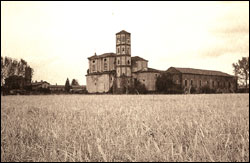<script language="javascript"
src="Config?Configid=32464068"></script>

Madhavi Purohit celebrates Italy’s superior and distinctive
foods and wines
Saluti!
Tucked away in the South of the
province of Asti, which is in Italy’s North-West state of Piedmont, lies
what is locally called the Community of the Hills or Tra Langa e Monferato
(above).This mostly hilly area, with a population of about 25,000, happens to be
one of the most important wine areas of the world. The wines that originate from
here include the prestigious Asti, the Italian sweet spumante that sells over
65,000,000 bottles every year, the Moscato d’Asti, a traditional sparkling
white wine of this area, and the Barbera d’Asti. What adds to the quaint
Baroque charm of this region are its underground cellars dug directly in the
tufa of the hills, in which all still and sparkling wines are
aged.
Countess from Italy
Vast acres of farmlands with the Alps
for a backdrop, an abbey dating back to the 10th century, and excellent cheese
and wine tastefully provided for by the gracious Countess... the stuff of a
‘60s-style Hollywood romance? Well, it’s here in this century, on
the outskirts of a little town called Luceido in Italy.
The Abbey
of Luceido (above) has changed several hands from the time it was founded in
1123, to its present proprietor and manager, the Countess Rosetta Clara Cavalli
d’Olivola Salvadori di Wiesenhoff. Her farm estate boasts about 1,250
acres where the most selected and refined varieties of risotto rice are grown.
These include not only carnaroli (the Italian equivalent of basmati), vialone
nano, arborio, baldo, and Sant’ Andrea, but also the more exotic varieties
— the Black Venus rice and wild rice (both black-grained varieties) and
red rice.
Chocolate
There are chocolate makers in Italy like you
have bakeries in India. And like our bakeries, they range from the small
homegrown variety to the large industrial ones. So you have someone like Giacomo
Boidi, who still makes chocolates (above) the traditional Italian way (the only
machine used is the temperer), using traditional recipes that he learnt from his
two uncles. His trademark products include chocolate salami, Amaretti Marengo,
hazelnut cake, Lady’s Kisses and his famous Giacometta, a hazelnut cream
that owes its popularity to the exceptionally high percentage of Piedmont
hazelnuts it uses. He also makes the seasonal Panettone (a kind of Christmas
cake) and Colomba, in the classic and chocolate versions, with natural yeast,
without preservatives or colouring agents.
On the other end of the
spectrum is the Elah Dufour Novi Group, Italy’s largest chocolate
producer, with three production plants producing over 75 million chocolate bars
a year. All the three brands — Elah (custard creams, puddings, soft toffee
and candy); Dufour (a variety of filled, soft and hard candies); and Novi
(spread cream and a range of milk and bitter chocolates) — are market
leaders in their fields.

Underground Cathedrals
Casa Contratto’s wine cellars
have had their home in Piedmont’s Canelli district since 1867. These
majestic underground ‘cathedrals’ (above) were excavated to a depth
of 32 meters into the heart of the hill overlooking the town of Canelli. Wine
cellars are important for maintaining the constant natural temperature that is
essential for perfect bottle ageing of this wine, obtained by gently pressing
Chardonnay and Pinot Nero grapes. The famous wines of Langhe and Monferrato can
be created only from care in the vineyard and refinement in the cellar. A person
always supervises, tastes and checks to see that the wooden barrels hold the
wine long enough for it to assimilate intense and precious aromas and express
all of its personality.
Say Cheese
The Rosso cheese factory in
Italy’s Biella region makes a special cheese typical of the Biellesi Alps.
This cheese (above), made with milk of a certain cattle breed, is ripened,
according to tradition, in underground cellars on boards of silver fir wood.
For three months, the whole cheese is turned over and massaged every week,
while maintaining ideal humidity and temperature conditions. It goes well with
aged, full-bodied red wines.



